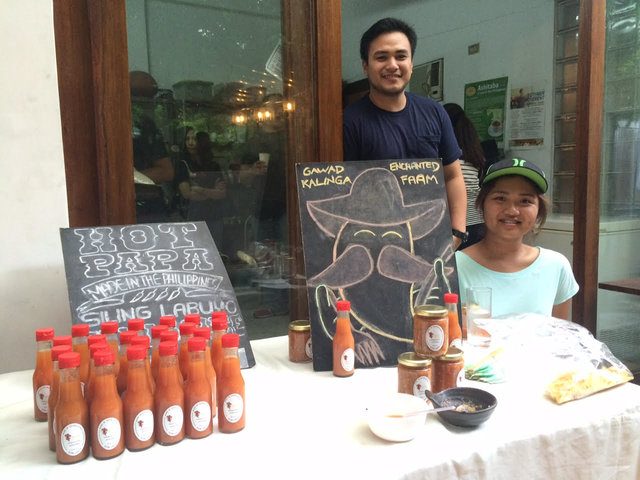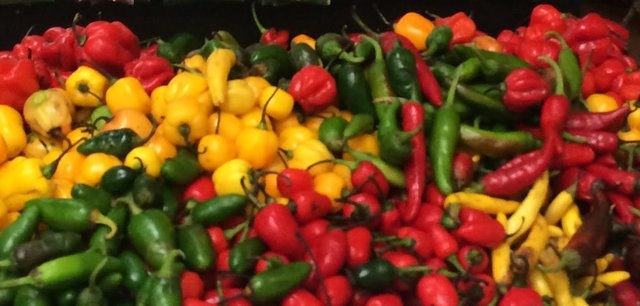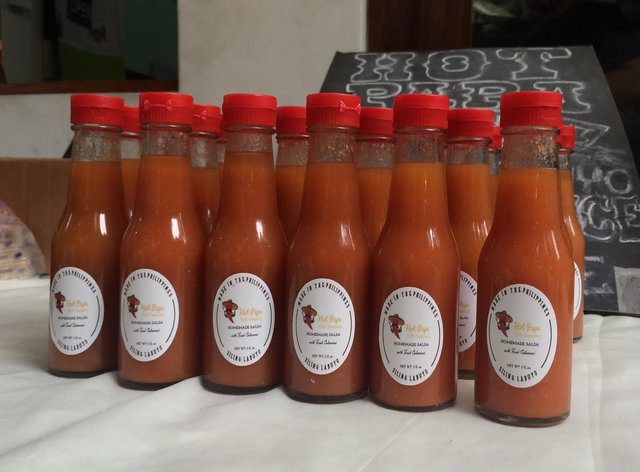SUMMARY
This is AI generated summarization, which may have errors. For context, always refer to the full article.

Superhots, of species Capsicum chinense, are the stuff tongue-torching, soul-burning sauces are made of.
Packing up to more than 500,000 Scoville Heat Units – a way of measuring the pungency of peppers – they are at least 3 times hotter than the labuyo and 10 times hotter than the Taiwan type, which are both grown in the country.
Because the market loves mean chilies, this variety is also priced higher internationally.
Compared to local hot sauces that retail from P18 ($0.40) to P80 ($1.77), “superhots sell at P250 ($5.37) up to P1,000 ($22.18) for the bigtime superhot sauces,” said Alfonso ‘Ponchit’ Ponce Enrile.
Cultivating them in the Philippines is a good commercial opportunity not only for farmers, but also for agripreneurs who process fresh pods and seeds into finished products such as hot sauces, salsas, canned sardines, chocolates, and cookies.
Chili heads of Manila
Ponce Enrile belongs to a low-profile yet expanding alliance of almost 3,000 chili farmers, gardeners, seed/pod or end product sellers, and enthusiasts called Chilliheads Philippines (CHP).
They aim to promote the cultivation of superhot chilies and the manufacture of superhot sauces in the country.
With this goal in mind, the group held its second Chili Festival on July 4 and 5 on Maginhawa Street, in the kitchen garden of fellow advocate Daisy Langenegger.
“The advocacy is still in its infancy,” said Ponce Enrile. The whole festival cost P16,000 ($354.87) without the benefit of sponsors. Instead, it ran on the goodwill of benefactors who provided “small funds, free space, [and] free publicity.”
Around 500 guests came to the event, near-thrice the number of those who attended the first in October 2014.

Introducing superhots
The home market is familiar with 4 chili varieties.
The labuyo (Capsicum frutescens) – which has been native in the land for centuries though it was actually from Mexico – is easy to grow, hard to harvest because of its tiny size, and is expensive.
The ubiquitous siling Taiwan is the backbone of the chili industry. “Canning factories especially sardine manufacturers, restaurants like Mang Inasal…and companies that make hot sauces and other preparations that need heat” use this variety, according to Ponce Enrile.
Siling panigang – the green kind that also goes with cheese in a starter called dynamite – and the bell or sweet pepper are the other two.
Superhots enter as the newcomer with the nuclear heat that has taken over the world. Like fruits that are turned into wine, chilies are differentiated by variety, origin, and harvest time. Ponce Enrile is positive that the country can produce superhots that chili connoisseurs can appreciate.
Here lies the challenge: “Farmers are hesitant because there are no manufacturers to absorb their produce and manufacturers are hesitant because of the lack of supply. A case of the chicken and egg question,” he said.
The festival was their means to connect small producers with artisanal hot sauce manufacturers, and the latter with superhot sauce consumers.
Sharing the joy
RJ’s Chilli Cookies was one of the non-conventional takes in crafting pepper-based food at the festival. The hot cookies made by Jocelyn Francisco were sold out on day one.
Francisco raises chili and bakes cookies at home. Her business started out of a hobby, which is founded on simply sharing the joy of eating tasty desserts and snacks. Now, she said, “we are receiving incoming orders. We are even surprised because children as young as 7 years old can eat our hot cookies. We can say that both young and old appreciate the mildness of their flavor.”
Aside from the current hot chili cinnamon flavor, which adults love, RJ’s is in the process of introducing hot chocolate brownies.
A chili lover, especially of bells, Francisco discovered CHP on social media. After joining, she learned that the Facebook group also featured superhots. She was hooked and then began attending major CHP gatherings such as Christmas programs and festivals.

Limiting the need to import
A rookie in the Chili Festival found a winner in its chili salsa. Hot Papa is a business borne from the partnership of hot sauce junkie Auie Anatalio and Cali-Mex food enthusiast Martin Nunga, backed by the support of Gawad Kalinga through the GK Enchanted Farm.
Beyond making bottles of hot sauce and salsa, Hot Papa’s young entrepreneurs are also planting their own seeds in hopes of limiting the need to import fresh pods and processed goods.
According to Nunga, “Tony Meloto assigned us a parcel of land to begin our dream of producing chilies and creating a social enterprise that is able to share this with all Filipinos.”
Ultimately, the partners seek to endorse chili as a cash crop in the Philippines, similar to the trend in India, Mexico, Turkey, and the US; to supply the domestic market as value for chili as a marketable vegetable increases; and to eventually scale to the global market.
Giving back to community
As chili is still classified as a niche market, Francisco said that RJ’s Chilli Cookies centers less on profits and more on the principle of providing “a healthy, palatable, and entertaining product” to consumers.
Francisco said she adjusts the amount of ingredients, such as sugar or butter, in her hot cookies for the health conscious, all without compromising the flavor and price.
Meanwhile, through Hot Papa, Nunga and Anatolia are able to give back to the community.
“We are purchasing products from local markets and we are beginning to work with the community: acquiring the help of titas in the kitchen and kuyas at the GK Enchanted Farm to structure our organization,” Nunga said.
Their participation in CHP will also boost their efforts to realize their objectives.
Switching to superhots
While CHP strives to remain low key, Ponce Enrile said the core members have agreed to seek technical assistance from the Department of Agriculture in UP Los Baños and the Department of Science and Technology. This is in line with their plan to create a manual for growing chilies.
CHP is also looking at securing a seminar with the Food and Drug Administration regarding the registration and approval of its members’ chili products.
While working on their strategy, CHP will continue to heat things up by encouraging agripreneurs to switch to superhots. Taiwan chili is already grown by the thousands in China, India, and other countries for the dried chili market. A kilo of dried chili is sold at P160 ($3.55), which translates to P32 ($0.71) per kilo of fresh pods.
“That’s super cheap. We should go for superhots that sell P100 ($2.22) per kilo of fresh pods,” he added.
Traditional superhots like the orange and red habaneros, the bhut jolokia peppers of India, and the fatalii peppers of Africa are quite easy and not so expensive to grow, Ponce Enrile said. “I see no reason why we can’t grow them commercially here in our country.” – Rappler.com
$1=P45.09
Shadz Loresco is a freelance business writer for both online and print. Follow her on Twitter: @shadzloresco.
Add a comment
How does this make you feel?
There are no comments yet. Add your comment to start the conversation.